cooling TOYOTA LAND CRUISER 2013 J200 Owners Manual
[x] Cancel search | Manufacturer: TOYOTA, Model Year: 2013, Model line: LAND CRUISER, Model: TOYOTA LAND CRUISER 2013 J200Pages: 720, PDF Size: 21.46 MB
Page 526 of 720
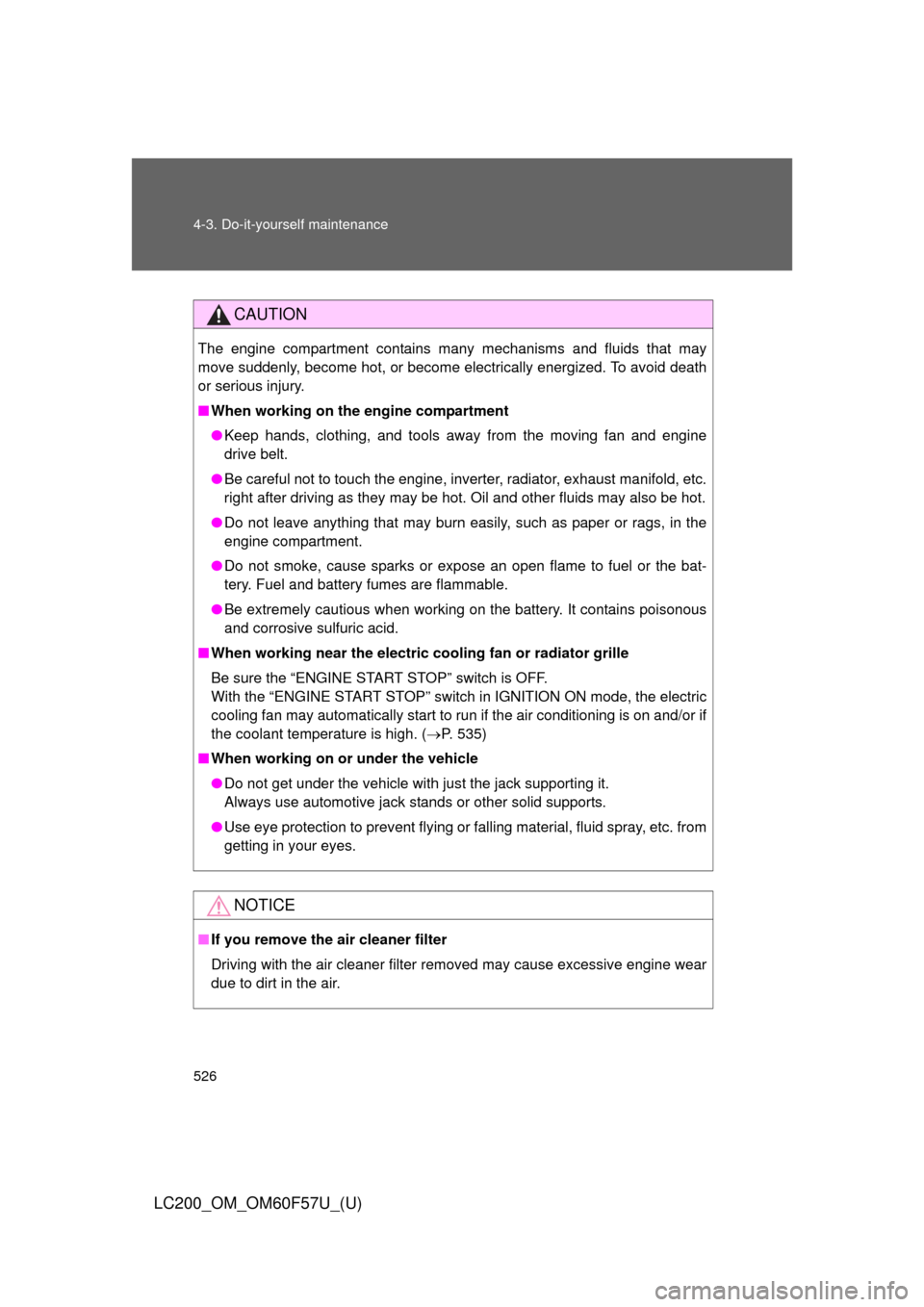
526 4-3. Do-it-yourself maintenance
LC200_OM_OM60F57U_(U)
CAUTION
The engine compartment contains many mechanisms and fluids that may
move suddenly, become hot, or become electrically energized. To avoid death
or serious injury.
■When working on the engine compartment
●Keep hands, clothing, and tools away from the moving fan and engine
drive belt.
●Be careful not to touch the engine, inverter, radiator, exhaust manifold, etc.
right after driving as they may be hot. Oil and other fluids may also be hot.
●Do not leave anything that may burn easily, such as paper or rags, in the
engine compartment.
●Do not smoke, cause sparks or expose an open flame to fuel or the bat-
tery. Fuel and battery fumes are flammable.
●Be extremely cautious when working on the battery. It contains poisonous
and corrosive sulfuric acid.
■When working near the electric cooling fan or radiator grille
Be sure the “ENGINE START STOP” switch is OFF.
With the “ENGINE START STOP” switch in IGNITION ON mode, the electric
cooling fan may automatically start to run if the air conditioning is on and/or if
the coolant temperature is high. (P. 535)
■When working on or under the vehicle
●Do not get under the vehicle with just the jack supporting it.
Always use automotive jack stands or other solid supports.
●Use eye protection to prevent flying or falling material, fluid spray, etc. from
getting in your eyes.
NOTICE
■If you remove the air cleaner filter
Driving with the air cleaner filter removed may cause excessive engine wear
due to dirt in the air.
Page 528 of 720
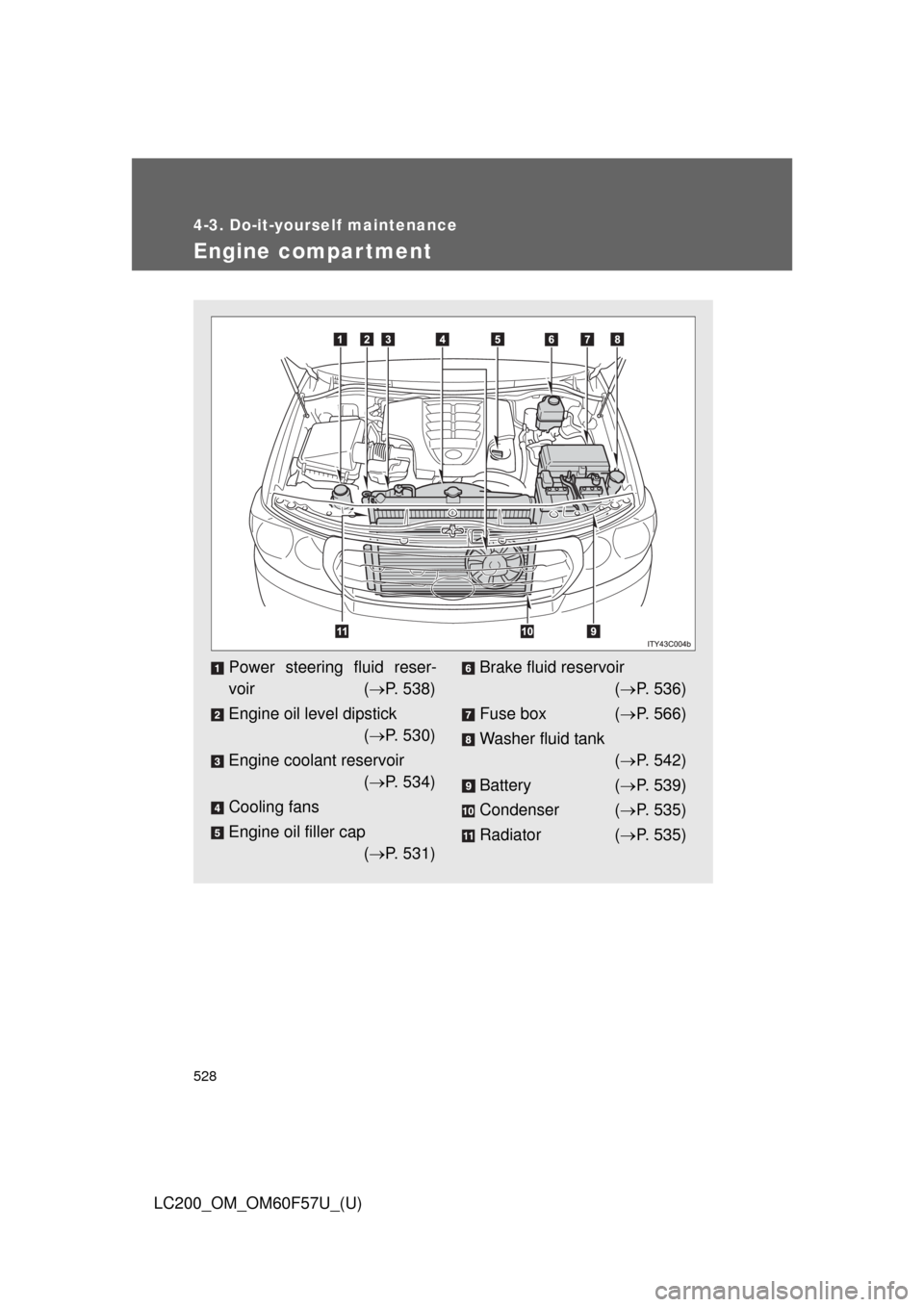
528
4-3. Do-it-yourself maintenance
LC200_OM_OM60F57U_(U)
Engine compar tment
Power steering fluid reser-
voir (P. 538)
Engine oil level dipstick
(P. 530)
Engine coolant reservoir
(P. 534)
Cooling fans
Engine oil filler cap
(P. 531)Brake fluid reservoir
(P. 536)
Fuse box (P. 566)
Washer fluid tank
(P. 542)
Battery (P. 539)
Condenser (P. 535)
Radiator (P. 535)
Page 534 of 720
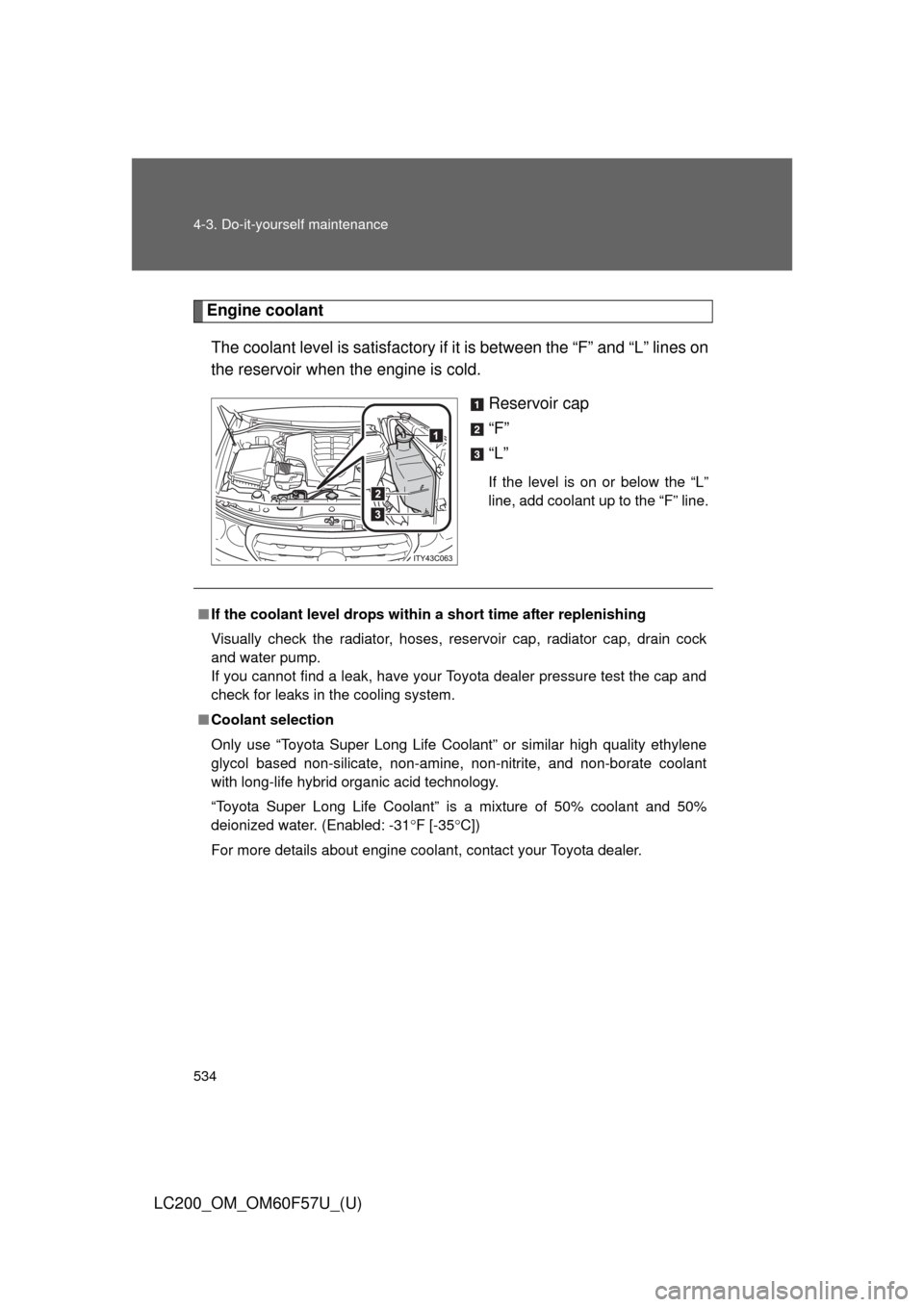
534 4-3. Do-it-yourself maintenance
LC200_OM_OM60F57U_(U)
Engine coolant
The coolant level is satisfactory if it is between the “F” and “L” lines on
the reservoir when the engine is cold.
Reservoir cap
“F”
“L”
If the level is on or below the “L”
line, add coolant up to the “F” line.
■If the coolant level drops within a short time after replenishing
Visually check the radiator, hoses, reservoir cap, radiator cap, drain cock
and water pump.
If you cannot find a leak, have your Toyota dealer pressure test the cap and
check for leaks in the cooling system.
■Coolant selection
Only use “Toyota Super Long Life Coolant” or similar high quality ethylene
glycol based non-silicate, non-amine, non-nitrite, and non-borate coolant
with long-life hybrid organic acid technology.
“Toyota Super Long Life Coolant” is a mixture of 50% coolant and 50%
deionized water. (Enabled: -31F [-35C])
For more details about engine coolant, contact your Toyota dealer.
Page 535 of 720
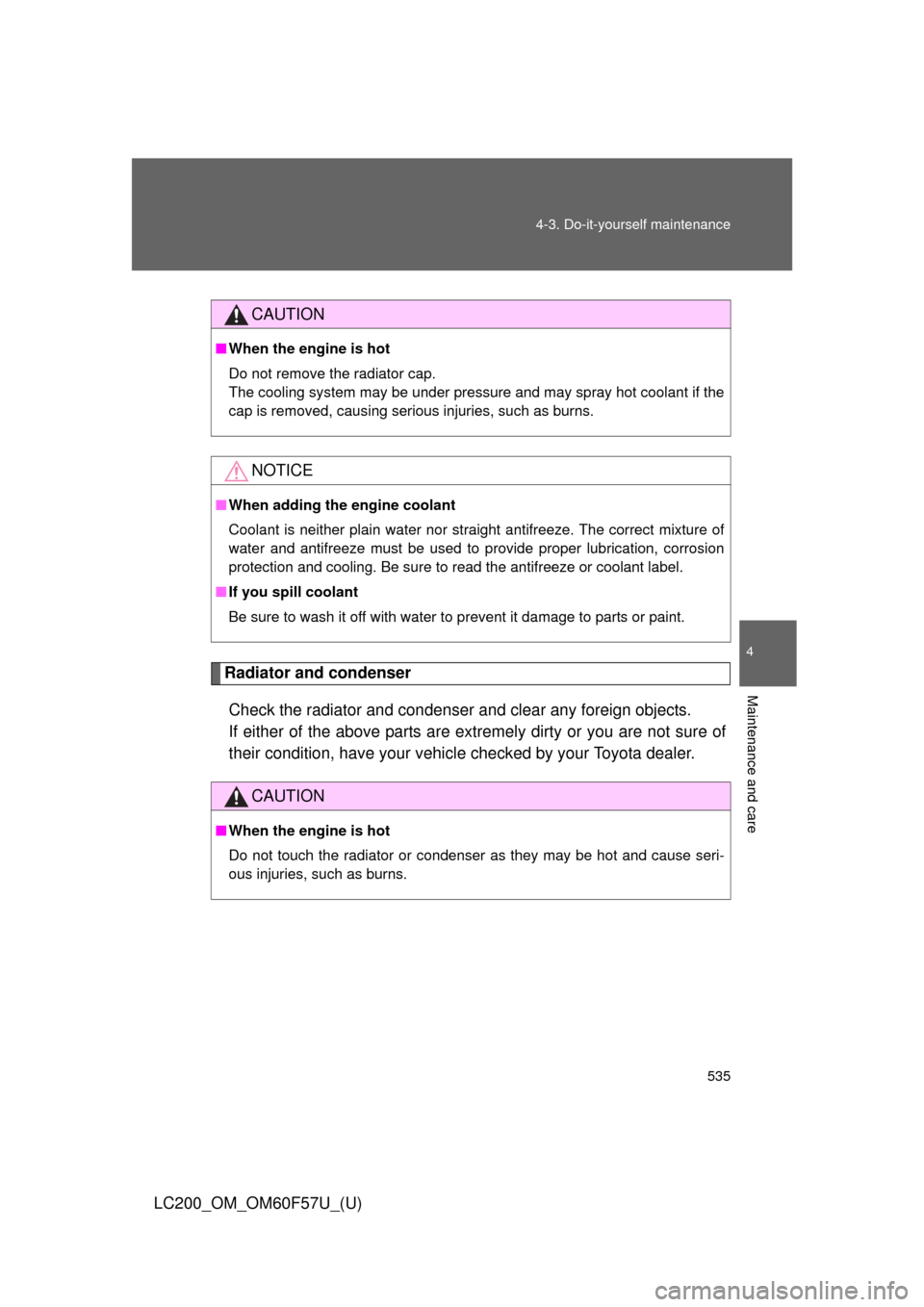
535 4-3. Do-it-yourself maintenance
4
Maintenance and care
LC200_OM_OM60F57U_(U)
Radiator and condenser
Check the radiator and condenser and clear any foreign objects.
If either of the above parts are extremely dirty or you are not sure of
their condition, have your vehicle checked by your Toyota dealer.
CAUTION
■When the engine is hot
Do not remove the radiator cap.
The cooling system may be under pressure and may spray hot coolant if the
cap is removed, causing serious injuries, such as burns.
NOTICE
■When adding the engine coolant
Coolant is neither plain water nor straight antifreeze. The correct mixture of
water and antifreeze must be used to provide proper lubrication, corrosion
protection and cooling. Be sure to read the antifreeze or coolant label.
■If you spill coolant
Be sure to wash it off with water to prevent it damage to parts or paint.
CAUTION
■When the engine is hot
Do not touch the radiator or condenser as they may be hot and cause seri-
ous injuries, such as burns.
Page 657 of 720
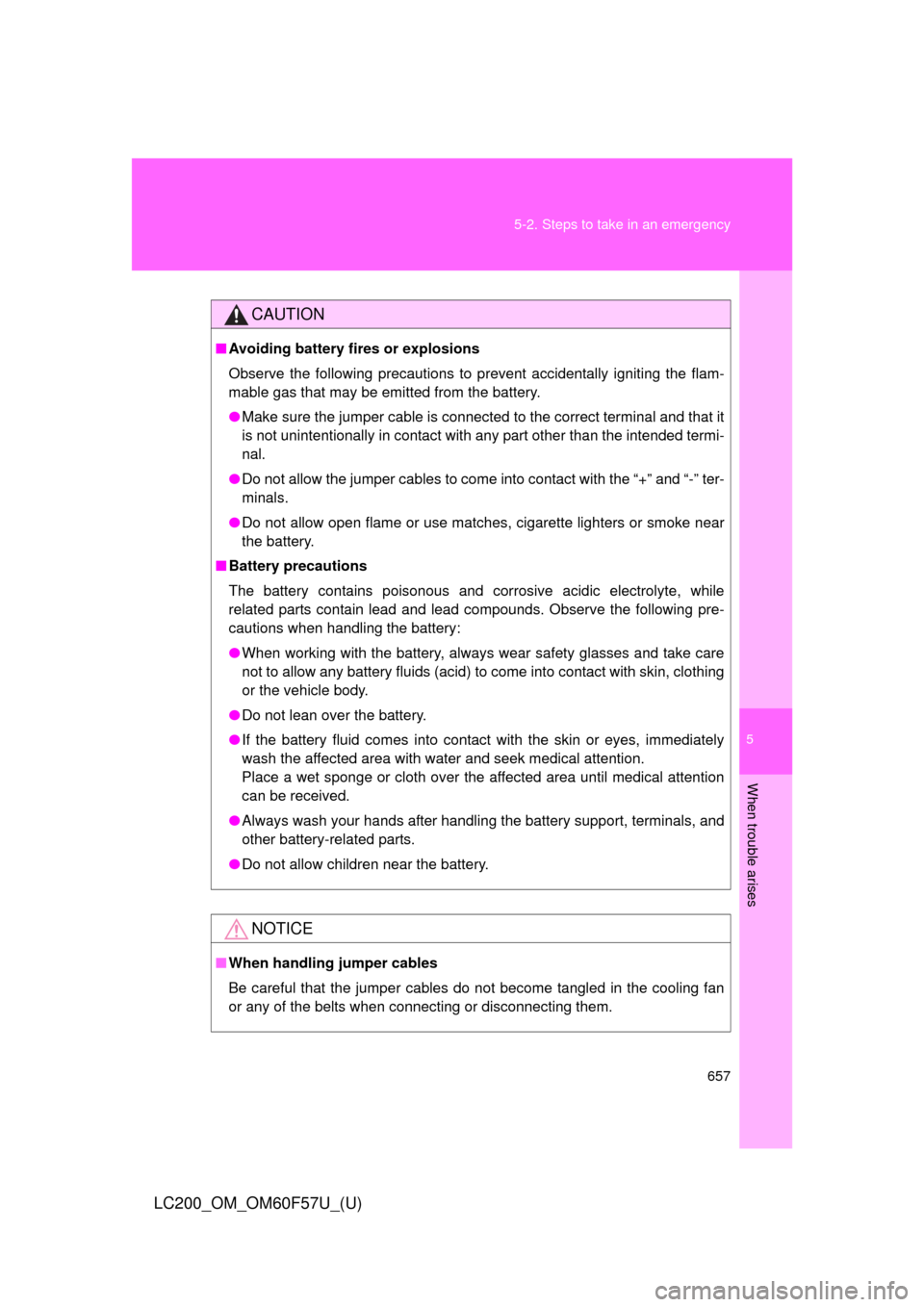
5
When trouble arises
657 5-2. Steps to take in an emergency
LC200_OM_OM60F57U_(U)
CAUTION
■Avoiding battery fires or explosions
Observe the following precautions to prevent accidentally igniting the flam-
mable gas that may be emitted from the battery.
●Make sure the jumper cable is connected to the correct terminal and that it
is not unintentionally in contact with any part other than the intended termi-
nal.
●Do not allow the jumper cables to come into contact with the “+” and “-” ter-
minals.
●Do not allow open flame or use matches, cigarette lighters or smoke near
the battery.
■Battery precautions
The battery contains poisonous and corrosive acidic electrolyte, while
related parts contain lead and lead compounds. Observe the following pre-
cautions when handling the battery:
●When working with the battery, always wear safety glasses and take care
not to allow any battery fluids (acid) to come into contact with skin, clothing
or the vehicle body.
●Do not lean over the battery.
●If the battery fluid comes into contact with the skin or eyes, immediately
wash the affected area with water and seek medical attention.
Place a wet sponge or cloth over the affected area until medical attention
can be received.
●Always wash your hands after handling the battery support, terminals, and
other battery-related parts.
●Do not allow children near the battery.
NOTICE
■When handling jumper cables
Be careful that the jumper cables do not become tangled in the cooling fan
or any of the belts when connecting or disconnecting them.
Page 658 of 720
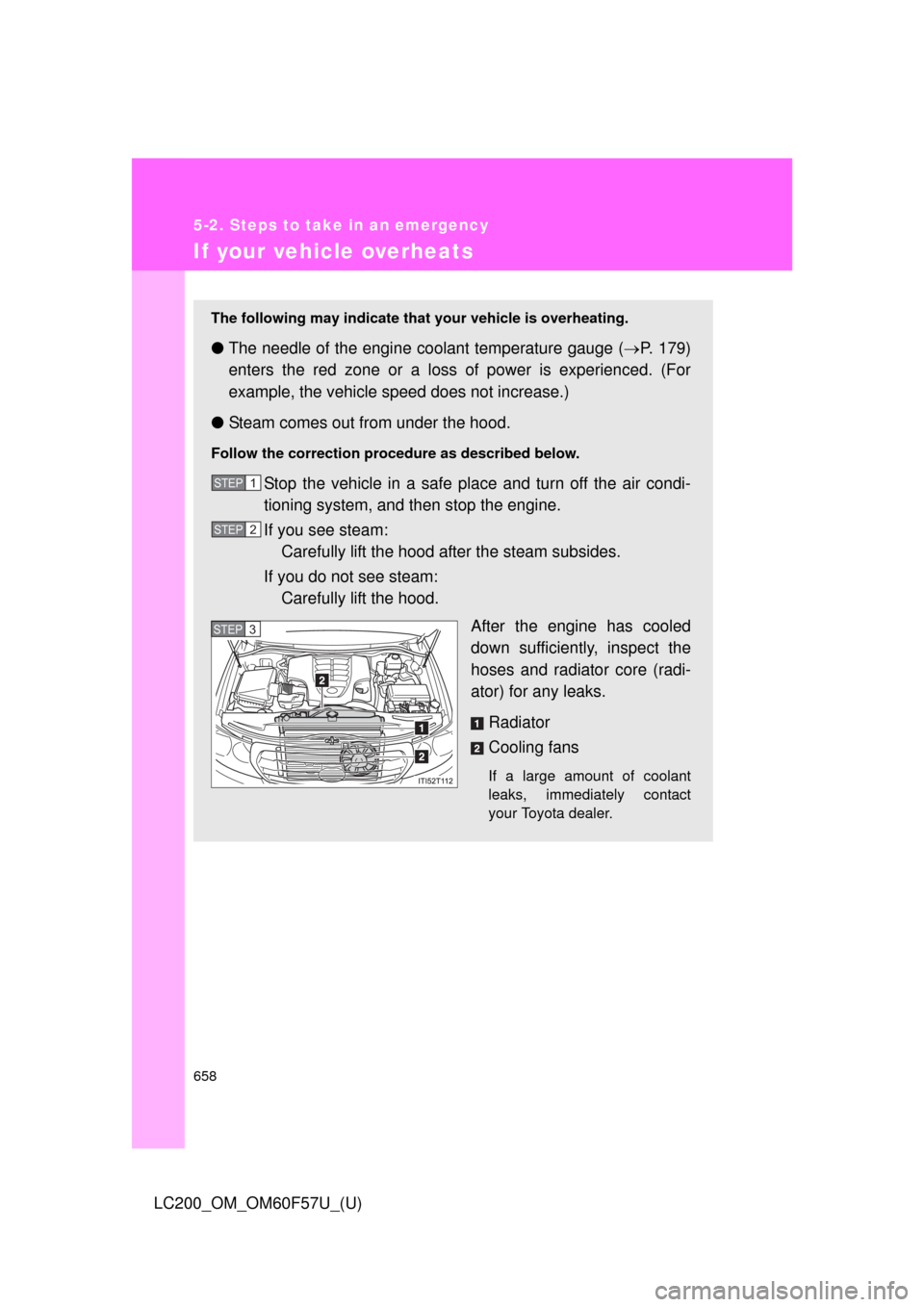
658
5-2. Steps to take in an emergency
LC200_OM_OM60F57U_(U)
If your vehicle overheats
The following may indicate that your vehicle is overheating.
●The needle of the engine coolant temperature gauge (P. 179)
enters the red zone or a loss of power is experienced. (For
example, the vehicle speed does not increase.)
●Steam comes out from under the hood.
Follow the correction procedure as described below.
Stop the vehicle in a safe place and turn off the air condi-
tioning system, and then stop the engine.
If you see steam:
Carefully lift the hood after the steam subsides.
If you do not see steam:
Carefully lift the hood.
After the engine has cooled
down sufficiently, inspect the
hoses and radiator core (radi-
ator) for any leaks.
Radiator
Cooling fans
If a large amount of coolant
leaks, immediately contact
your Toyota dealer.
STEP1
STEP2
STEP3
Page 659 of 720
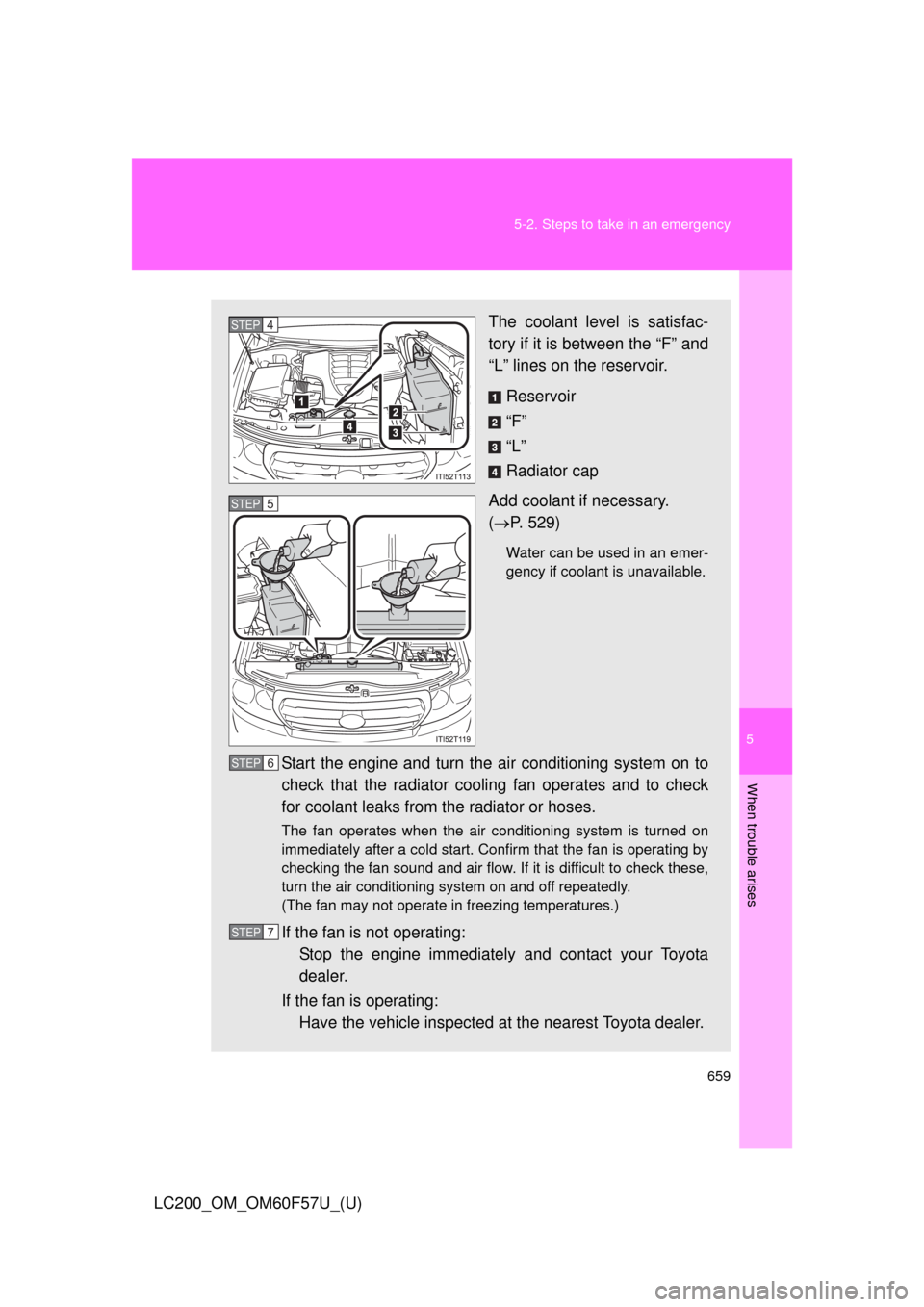
5
When trouble arises
659 5-2. Steps to take in an emergency
LC200_OM_OM60F57U_(U)
The coolant level is satisfac-
tory if it is between the “F” and
“L” lines on the reservoir.
Reservoir
“F”
“L”
Radiator cap
Add coolant if necessary.
(P. 529)
Water can be used in an emer-
gency if coolant is unavailable.
Start the engine and turn the air conditioning system on to
check that the radiator cooling fan operates and to check
for coolant leaks from the radiator or hoses.
The fan operates when the air conditioning system is turned on
immediately after a cold start. Confirm that the fan is operating by
checking the fan sound and air flow. If it is difficult to check these,
turn the air conditioning system on and off repeatedly.
(The fan may not operate in freezing temperatures.)
If the fan is not operating:
Stop the engine immediately and contact your Toyota
dealer.
If the fan is operating:
Have the vehicle inspected at the nearest Toyota dealer.
STEP4
STEP5
STEP6
STEP7
Page 660 of 720
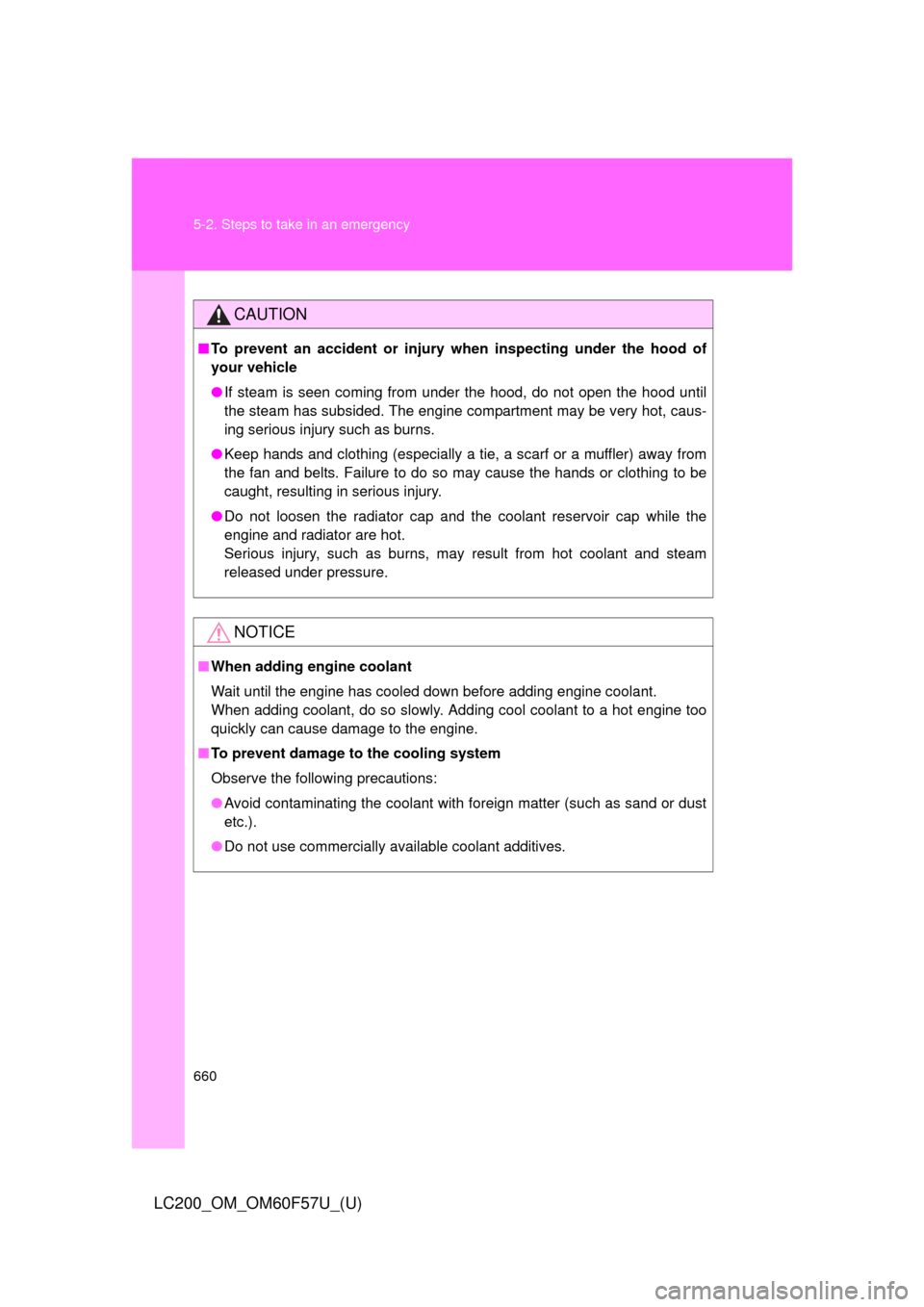
660 5-2. Steps to take in an emergency
LC200_OM_OM60F57U_(U)
CAUTION
■To prevent an accident or injury when inspecting under the hood of
your vehicle
●If steam is seen coming from under the hood, do not open the hood until
the steam has subsided. The engine compartment may be very hot, caus-
ing serious injury such as burns.
●Keep hands and clothing (especially a tie, a scarf or a muffler) away from
the fan and belts. Failure to do so may cause the hands or clothing to be
caught, resulting in serious injury.
●Do not loosen the radiator cap and the coolant reservoir cap while the
engine and radiator are hot.
Serious injury, such as burns, may result from hot coolant and steam
released under pressure.
NOTICE
■When adding engine coolant
Wait until the engine has cooled down before adding engine coolant.
When adding coolant, do so slowly. Adding cool coolant to a hot engine too
quickly can cause damage to the engine.
■To prevent damage to the cooling system
Observe the following precautions:
●Avoid contaminating the coolant with foreign matter (such as sand or dust
etc.).
●Do not use commercially available coolant additives.
Page 670 of 720
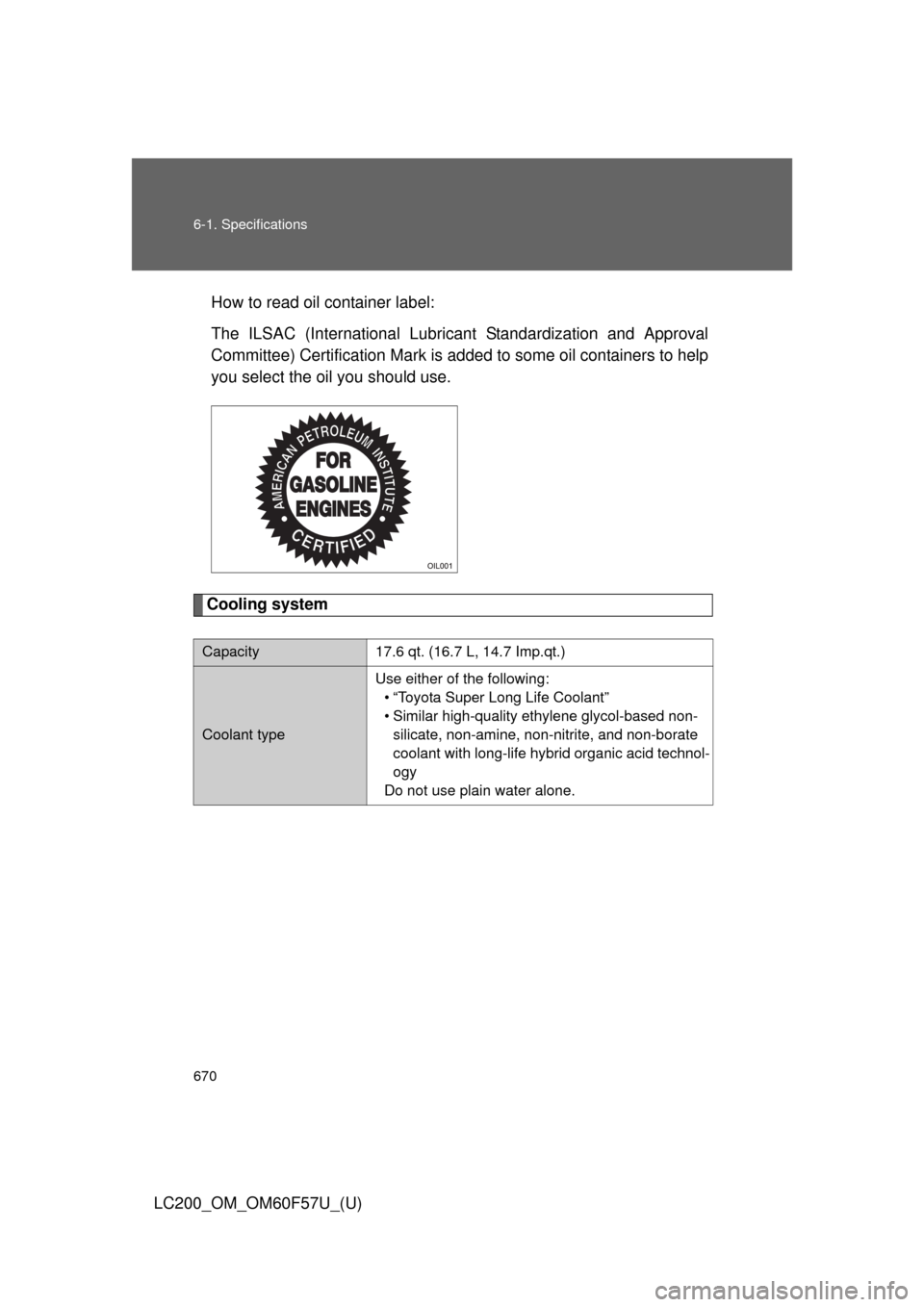
670 6-1. Specifications
LC200_OM_OM60F57U_(U)How to read oil container label:
The ILSAC (International Lubricant Standardization and Approval
Committee) Certification Mark is added to some oil containers to help
you select the oil you should use.
Cooling system
Capacity17.6 qt. (16.7 L, 14.7 Imp.qt.)
Coolant type
Use either of the following:
• “Toyota Super Long Life Coolant”
• Similar high-quality ethylene glycol-based non-
silicate, non-amine, non-nitrite, and non-borate
coolant with long-life hybrid organic acid technol-
ogy
Do not use plain water alone.
Page 710 of 720

710 Alphabetical index
LC200_OM_OM60F57U_(U)
Child safety
Airbag precautions ................122
Battery precautions ....... 541, 565
Child-protectors ....................... 47
Child restraint system............135
How your child should wear
the seat belt ..........................81
Installing child restraints ........ 140
Moon roof precautions .......... 100
Power window lock switch....... 93
Power window precautions .....96
Removed key battery
precautions .........................563
Seat belt extender
precautions ...........................84
Seat belt precautions ..............82
Seat heater precautions ........ 490
Cigarette lighter ....................... 484
Cleaning
Exterior .................................. 512
Interior ...................................515
Seat belts ..............................516
Clock (vehicles without
navigation system). ............... 479
Clock (vehicles with
navigation system)
*
Condenser ................................535
Console box ............................. 468
Cool box.................................... 475
Cooling system
Engine overheating ............... 658
Crawl Control ...........................245
Cruise control...........................210
Cup holder ................................470
Curtain shield airbags ............. 113
Customizable features............. 692Daytime running light
system .................................... 199
Defogger
Rear window ......................... 351
Side mirror ............................ 351
Dimension ................................ 666
Dinghy towing .......................... 333
Display
Crawl Control display ............ 245
Dynamic radar cruise
control ................................. 214
Intuitive parking assist
display ................................ 229
Multi-information display ....... 189
Shift position and shift
range .................................. 173
Trip information ..................... 190
Warning messages ............... 617
Do-it-yourself maintenance .... 524
Door courtesy lights
Door courtesy lights .............. 462
Wattage................................. 675
Door lock
Back door ................................ 51
Side door................................. 46
Wireless remote control key.... 44
Doors
Back door ................................ 51
Side door................................. 46
Side mirrors............................. 90
Driver’s seat belt reminder
light ......................................... 609
Driving
Break-in tips .......................... 155
Correct posture ..................... 111
Off-road precautions ............. 297
Procedures............................ 154
Winter driving tips ................. 310
Driving position memory .......... 68
Dynamic radar cruise
control .................................... 214
D